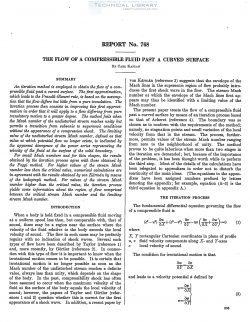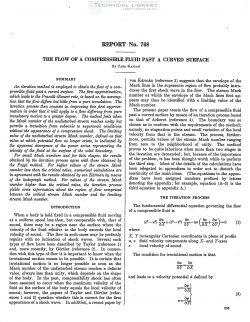naca-report-768

- Version
- 157 Downloads
- 1.47 MB File Size
- 1 File Count
- August 30, 2016 Create Date
- August 30, 2016 Last Updated
National Advisory Committee for Aeronautics, Report - The Flow of a Compressible Fluid Past a Curved Surface

An iteration method is employed to obtain the flow of a com-
pressiblefluid past a curved surface. The first approximation,
which leads to the Prandtl-G’lauert rule, is based on the assump-
tion that the flow difl'ers but little from a pure translation. The
iteration process then consists in improving this first approxi-
mation in order that it will apply to a flow difl'ering from pure
translatory motion to a greater degree. The method fails when
the Mach number of the undisturbed stream reaches unity but
permits a transition from subsonic to supersonic conditions
without the appearance of a compression shock. The limiting
value of the undisturbed stream Mach number, defined as that
value at which potential flow no longer exists, is indicated by
the apparent divergence of the power series representing the
velocity of the fluid at the surface of the solid boundary.
For small Mach numbers and for thin shapes, the results
obtained by the iteration process agree with those obtained by
the Poggi method. For higher values of the stream Mach
number less than the critical value, numerical calculations are
in agreement with the results obtained by von Kdrmdn by means
of the hodograph method. For values of the stream Mach
number higher than the critical value, the iteration process
yields some information about the region of flow comprised
between the critical stream Mach number and the limiting
stream Mach number.
When a body is held fixed in a compressible fluid moving
at a uniform speed less than, but comparable with, that of
sound, there may be a region near the surface where the
velocity of the fluid relative to the body exceeds the local
velocity of sound. The flow in such cases may be perfectly
regular with no indication of shock waves Several such
types of flow have been described by Taylor (reference 1)
and, more recently, by Gortler (reference 2). In connec-
tion with this type of flow it is important to lmow when the
irrotational motion ceases to be possible. It is certain that
irrotational motion is no longer possible as soon as the
Mach number of the undisturbed stream reaches a definite
value, always less than unity, which depends on the shape
of the body. In the past, compressibility shock has often
been assumed to occur when the maximum velocity of the
fluid at the surface of the body equals the local velocity of
sound; however, the papers of Taylor and Gortler (refer-
ences 1 and 2) question whether this is correct for the first
appearance of a shock wave.
| File | Action |
|---|---|
| naca-report-768 The Flow of a Compressible Fluid Past a Curved Surface.pdf | Download |

Comment On This Post